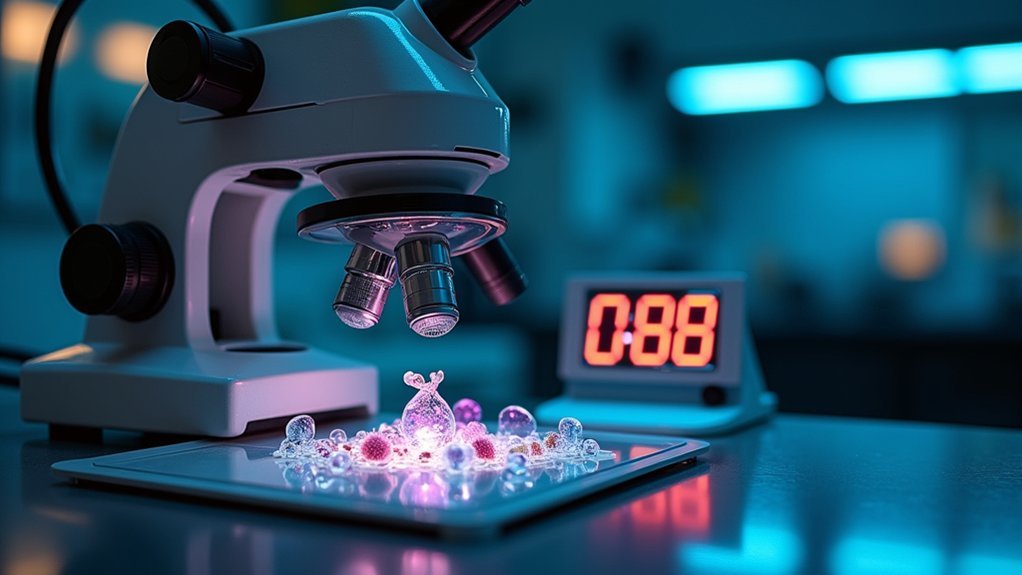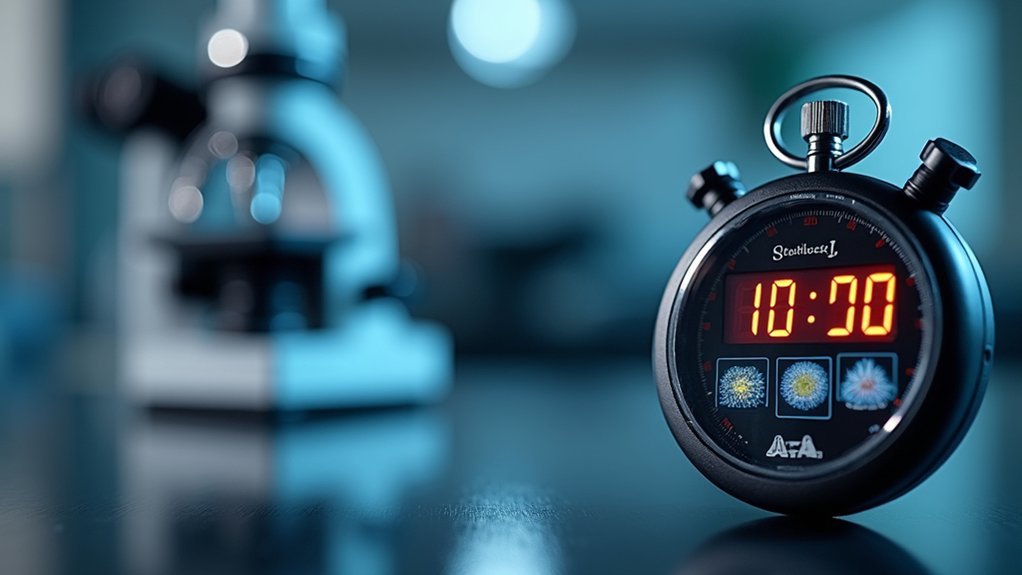To calculate time-lapse duration for your microscope experiments, multiply your total frame count by the time interval between captures. Choose intervals based on your specimen’s activity level—1 second for fast-moving organisms, 30 seconds for crystallization, or up to 1 hour for slow growth processes. Remember that environmental stability affects specimen viability throughout your recording period. Proper planning guarantees you’ll capture every critical moment of cellular dynamics without exceeding file size limitations.
Understanding Time-Lapse Fundamentals for Microscopy

Why do scientists rely on time-lapse microscopy? It’s because this technique compresses hours of cellular activity into seconds, revealing dynamic processes that would otherwise be imperceptible.
By capturing images at preset intervals, you’ll witness embryo development or cell migration as a fluid motion rather than static snapshots.
Time-lapse microscopy transforms discrete cellular events into continuous visual narratives, revealing life’s hidden choreography through sequential imaging.
Your time interval selection is critical—ranging from 1 second to 1 hour—and directly impacts temporal resolution. For rapid events like mitosis, shorter intervals are essential, while slower processes like differentiation can tolerate longer gaps between captures.
Success hinges on proper specimen preparation and environmental control during live cell imaging.
Modern digital still cameras compatible with microscopes make time-lapse more accessible than ever, allowing you to document biological phenomena with remarkable clarity and precision.
Essential Variables Affecting Time-Lapse Duration
When planning your time-lapse microscopy experiment, several key variables determine how long your observation will run. The time interval you select—ranging from 1 second to 1 hour—must match your specimen’s rate of change. Fast-moving subjects require shorter intervals, while slow-growing specimens need longer ones.
Your total time-lapse duration equals the number of frames multiplied by the time interval. For example, 120 frames at 1-minute intervals creates a 120-minute observation. Remember that file size (approximately 5 MB for AVI formats) effectively limits how many frames you can capture.
Don’t overlook environmental factors during extended time-lapse experiments. Temperature fluctuations and medium stability can affect specimen viability, potentially compromising your results.
Careful planning of these variables guarantees you’ll capture the complete biological process you’re studying.
Step-by-Step Duration Calculation Methods

Calculating accurate time-lapse durations requires a methodical approach to guarantee you’ll capture the full biological process under study. To determine your total duration, multiply your frame count by the time intervals between captures.
| Variable | Calculation Method |
|---|---|
| Total Duration | Frame Count × Time Interval |
| File Size Limit | (Max Size ÷ Single Frame Size) × Time Interval |
| Ideal Frame Rate | Process Duration ÷ Desired Capture Detail |
For example, capturing 120 frames at 30-second intervals yields a one-hour time-lapse movie. Adjust your capture settings based on specimen behavior—slower processes need longer intervals while faster movements require shorter ones. Always check your file size limitations, as many applications stop recording once they reach capacity, potentially cutting your time-lapse short.
Optimizing Intervals for Different Specimen Types
Different specimens require tailored time intervals to create meaningful time-lapse footage. When documenting slow processes like DDT crystallite formation, set your time intervals between 30 seconds to 1 minute to capture significant changes without excessive data.
For fast-moving specimens such as ants, shorter intervals of about 1 second will accurately document rapid behaviors.
Your choice of interval directly affects the temporal resolution of your final video. Higher temporal resolution becomes essential when capturing fast dynamics, while specimens exhibiting very slow growth may require intervals up to 1 hour.
Most time-lapse software allows you to adjust these settings based on your subject.
Always pre-determine your specimen characteristics before starting. This preliminary assessment guarantees you’ll select the most appropriate intervals for creating effective time-lapse sequences that truly represent the biological processes you’re studying.
Practical Examples of Time-Lapse Duration Planning

To illustrate effective time-lapse planning, let’s explore real-world examples that demonstrate how to calculate appropriate durations.
When capturing DDT crystallization, you’ll need approximately 360 frames at 30-second intervals, yielding a 3-hour Time-Lapse Microscopy session that thoroughly documents the slow growth process.
For studying ant movement, try 600 frames at 1-second intervals, creating a 10-minute time-lapse video that captures quick behaviors without overwhelming your disk space limitations of 5 MB.
Remember to adjust your time interval based on specimen viability.
For cell division experiments spanning multiple days, consider 5-minute intervals (288 frames per day), ensuring your environmental conditions remain stable throughout. This approach balances detailed documentation while preventing premature experiment termination due to storage constraints or specimen deterioration.
Frequently Asked Questions
How Do You Calculate Time-Lapse Duration?
To calculate time-lapse duration, you’ll need to determine your total observation time, set the interval between frames, then multiply your observation period by the number of intervals to find your total frame count.
What Is Time-Lapse Confocal Microscopy?
Time-lapse confocal microscopy is a technique you’ll use to capture sequential 3D images of living specimens over time. It reveals dynamic biological processes while minimizing photobleaching through controlled laser scanning at precise intervals.
What Is the Principle of Time-Lapse Microscopy?
Time-lapse microscopy’s principle is capturing images at set intervals to compress lengthy events into shorter viewable sequences. You’re fundamentally creating a video that shows slow processes unfolding rapidly through sequential imaging over time.
What Does Time-Lapse Duration Mean?
Time-lapse duration is the total period you’re recording over while capturing images at set intervals. It’s how long your experiment runs before you compile those images into a condensed, faster-playing video.
In Summary
You’ll get the most from your time-lapse experiments when you properly calculate duration and intervals. Remember to balance temporal resolution against photobleaching and phototoxicity risks. By tailoring your settings to your specific specimen and research question, you’re ensuring meaningful data collection. Start with conservative estimates, run pilot experiments, and refine your approach based on results. Your thoughtful planning will yield the dynamic cellular stories you’re seeking.





Leave a Reply